Lessons learned from warm Climates of the Past: an Ocean view from the Pliocene and an Interview with Alan Liu Geology Student

Seminar
Lessons learned from warm climates of the past: an ocean view from the Pliocene
Professor Erin McClymont
Last week we had Professor Erin McClymont, who came to the Hutton Club to talk about changing oceans and changing climates in the Pliocene. She is using information from the past changes of climate to understand how the climate is changing today and how it will change in the future. The data her team gathers is used to test modern climate models.
Dr Erin McClymont is a professor of organic geochemistry at the Department of Geography at the University of Durham. Her research interests are the following: Quaternary Environmental Change, Palaeoceanography, Palaeoclimate, Organic geochemistry (biomarkers), Marine ecosystems, Land-ocean interactions, Ocean-ice sheet interactions, Marine sediments. Her diverse knowledge of a wide range subjects, showed itself beautifully in her lecture.
Professor Erin McClymont – Professor in the Department of Geography
Lessons learned from warm climates of the past: an ocean view from the Pliocene
The key questions asked in the seminar
Past climates provide information for the future. By studying them through climate proxies we can answer questions like: How does the climate system respond to changing CO2? Where is the sensitivity or resilience in the climate system? What is the long term response versus the short term response?
Oxygen isotopes in the ice representing temperature change which are used to understand Pliocene-Pleistocene climate evolution.
The Pliocene may be an analogue for future climate (Why?):
1. CO2 has been reconstructed
2. Multiple dating methods
3. Orbital forcing of solar radiation is known
4. Similar continental configurations
5. Species extant today also present
Key questions:
1. Was CO2 responsible for the Climate Change?
2. How variable was late Pliocene climate?
3. What are the key forcings and changes?
International Ocean drilling programmes and most information comes from deep sea sediment cores. International collaboration – IODP Reports Expedition 341: Gulf of Alaska (2013), the key markers are Biomarkers, Microfossil chemistry, Ice-rafted debris. [1]
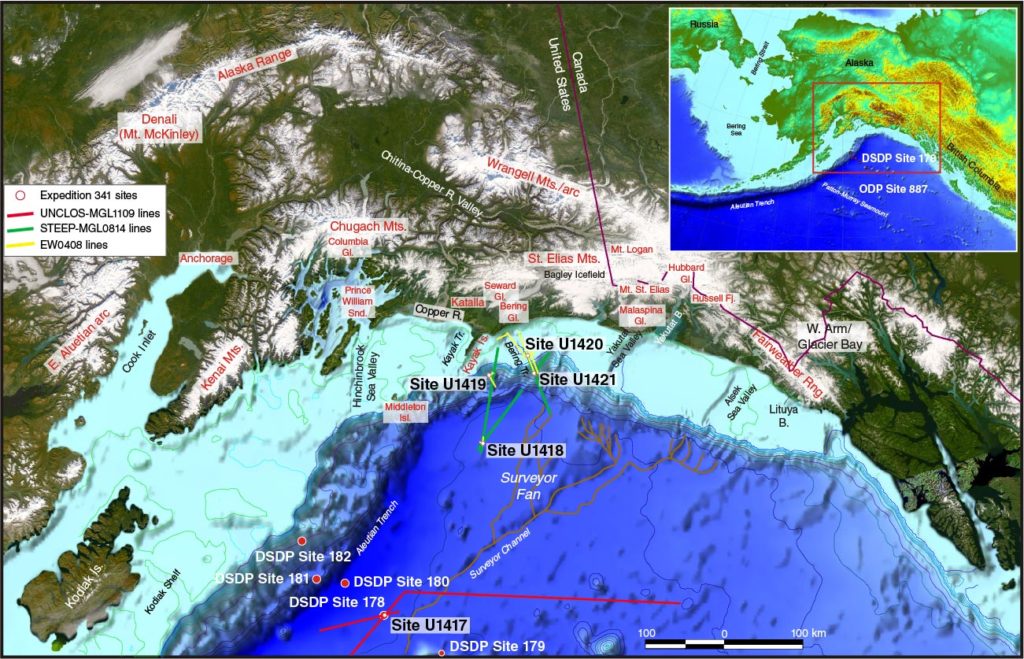
IODP Expedition 341 Scientists Southern Alaska Margin: interactions of tectonics, climate, and sedimentation. 2014.
How do we measure the past?
At sea calculation of sedimentary rates.
Larger glaciation on land was flushing more sediment into the sea, increasing the sedimentation rate.
Variable climate unlike as thought in the past. There was an expansion of ice on Alaska. Regular change in the sea temperatures, warmer oceans than today.
Data directly compared with modern computer models on the climate. Warmer oceans more evaporation.
Understanding the climate and the oceans around Alaska is key to understand the climate of the past.
How did oceans and climate interact?
At sea calculation of sedimentary rates.
Larger glaciation on land was flushing more sediment into the sea, increasing the sedimentation rate.
Variable climate unlike as thought in the past. There was an expansion of ice on Alaska. Regular change in the sea temperatures, warmer oceans than today. Data directly compared with modern computer models on the climate. Warmer oceans more evaporation. Understanding the climate and the oceans around Alaska is key to understand the climate of the past.
Techniques to understand the ocean underneath
Corelating the geology on land with the geology of the drilled cores. Geochemistry is key, sampled all across the globe.
How did the oceans respond on a large scale?
How do ocean temperatures respond to elevated atmospheric CO2?
The data and the model do not match. The past should have been warmer. The data and models are not recording the same thing.
Terrestrial data is different to ocean data. (Sediment provides a key source from drill holes.) Cancel out the orbital forcing and seeing how to ocean on their own reacted to the change in CO2. What is controlling the climate response? Global sampling of proxies need to be taken into account. It is all about getting the right data.
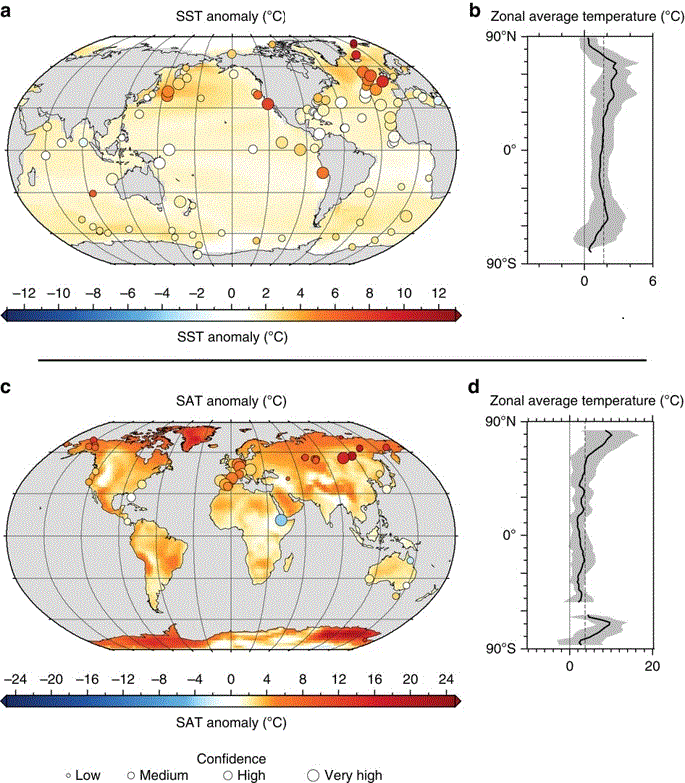
Comparison of Data and Models – International Panel on Climate Change (IPCC) data model comparison. Comparison of PRISM proxy data and the PlioMIP multimodel mean (MMM) simulation, (a) circles are PRISM SST anomalies, (b) zonally averaged PlioMIP MMM SST anomalies, (c) circles are PRISM land surface air temperature (SAT) anomalies, (d) zonally averaged MMM SAT anomalies. Zonal MMM gradients (b,d) are plotted with a shaded band indicating 2σ. Site-specific temperature anomalies estimated from PRISM proxy data are calculated relative to present site temperatures and are plotted (a,b) using the same colour scale as the model data, and a circle-size scaled to estimates of data confidence9,10,11. Modified from Box 5.1, Fig. 1,83.
Conclusions:
I have two things to take away from the seminar. It is amazing to me how broad the field is, how many research institutions it contains and how many expeditions it sends out, yet there is still a lot to explore and understand. There is a lot we don’t understand about how past climate change reflects modern climate change, as it is relatively new in the planet’s history for humans to start to pump carbon dioxide into the atmosphere.
My second take away was along the line of the oceans. In the lecture there was a particular focus on ocean circulation today and how it changed 22k ago. It was interesting to see how ocean circulation is studied using proxy isotopes.
These models are important for future projections on the Climate.
We can learn good lessons about the past climates:
• Pliocene ocean temperature warmer than today: CO2 forcing?
• Glaciation was developing (intensifying?)
• Important local and regional feedback at play
• High latitude ocean temperatures have < orbital scale variability
• How did marine ecosystems respond?
• Did ocean circulation change?
• Why are there still some data-data and data-model mismatches? [2]

Map of ocean circulation and SSTs.
My opinion of the seminar
Overall I enjoyed the seminar. It was great to have an overview of the past climates and how modern computer modelers are trying to understand them. It was great to see photos from the field, from the International ship drilling programmes. Dr Dirk Kroon gave many interesting lectures about the drill ship and how data is used from the recovered cores. It was great to have a greater background of knowledge as it put this seminar in the context of other lectures by the university.
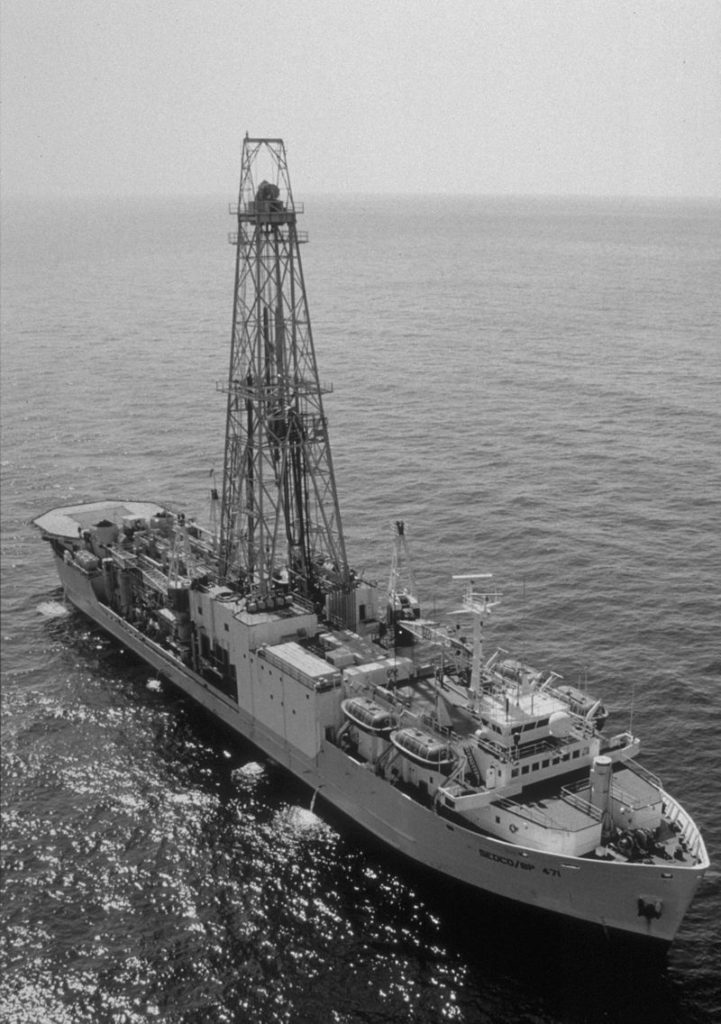
Drillship JOIDES Resolution in 1988
Interview
Interview with Alan Liu, Geologist of the young age
I interviewed Alan last week when we met in the Pub.
Alan Liu was a student of the University of Edinburgh in the subject of Geology from the years of 2017-2019. He is currently studying for his master’s degree at the University of Harriot-Watt, again in Edinburgh.
Alan is from the People’s Republic of China. He started his university education in China at the University of GeoSciences. He is in the UK as a visiting student.
I asked him a few questions to find out why he came to study here, how he got into geology and what he thinks the future has in store for him:
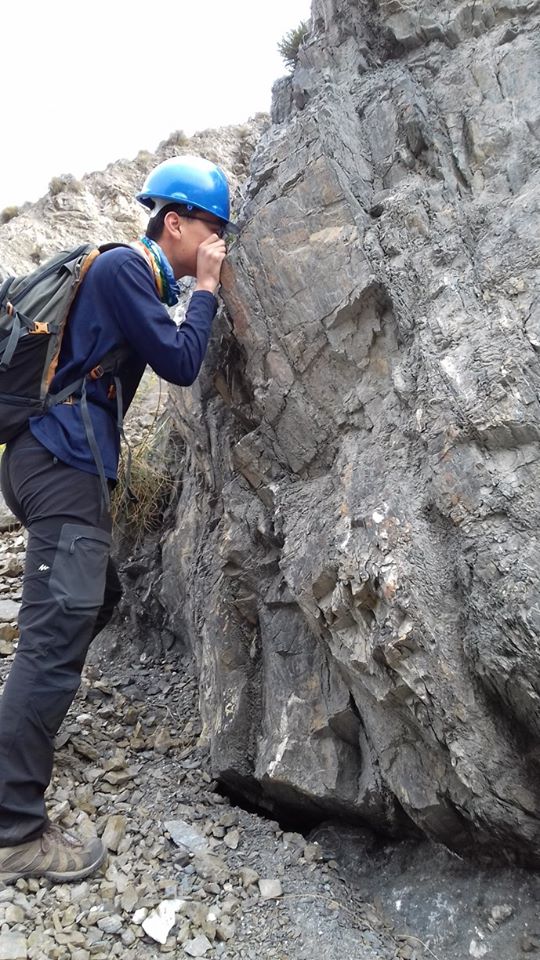
Alan Liu the geologist
1. Why did you choose Scotland and the University of Edinburgh?
We had 2 professors from the University of Edinburgh visit my university. That is when I realised the University of Edinburgh was an option.
They left a nice impression of the UK and the universities there. The UK is one of the original creators of the world-famous tertiary education.
The UK and Scotland has a great history! The UK has over 500 years’ worth of experience in teaching and research at universities.
The British brand is a world-famous brand. People respect education in that country greatly.
Edinburgh is a famous student town. The town has many great pubs and museums. A centre of education and a centre for the world.
Edinburgh is a great cultural centre, I enjoyed learning and participating in Scottish Culture.

Alan Liu, Leonluca Klein and Nils Van Weelderen visiting the Assynt GeoPark
2. What do you like about geology? Can you name a favourite site in China and a favourite site in Scotland?
Geology encourages me to learn more about what is happening under my feet. What is happening underground. Since I was a child I was curious about the science. I wanted to know how is it that a heavy building like a skyscraper could be supported by the ground.
In China, there are many nice sites!
Dongying, my hometown. It has the second largest oil field in China. It is made of sandstone sealed off by a rock cap of shale. It is a great place to learn geology.
Santorini volcano in Greece is a great site as well! The entire site was an ancient volcano that exploded in the times of Classical History!
My great Scottish site is from the KinlochLeven geology field trip. I saw great structural sites; Florian did a great job at explaining them. It was amazing to see Scottish nature. The trip greatly improved my knowledge of Scottish geology. Berit and Florian put so much of their hearts and souls into the trip, we were all inspired to learn more!It was great that they drove us onto the field and left us to our own devices to explore the local structures. I have nothing but praise for the university!
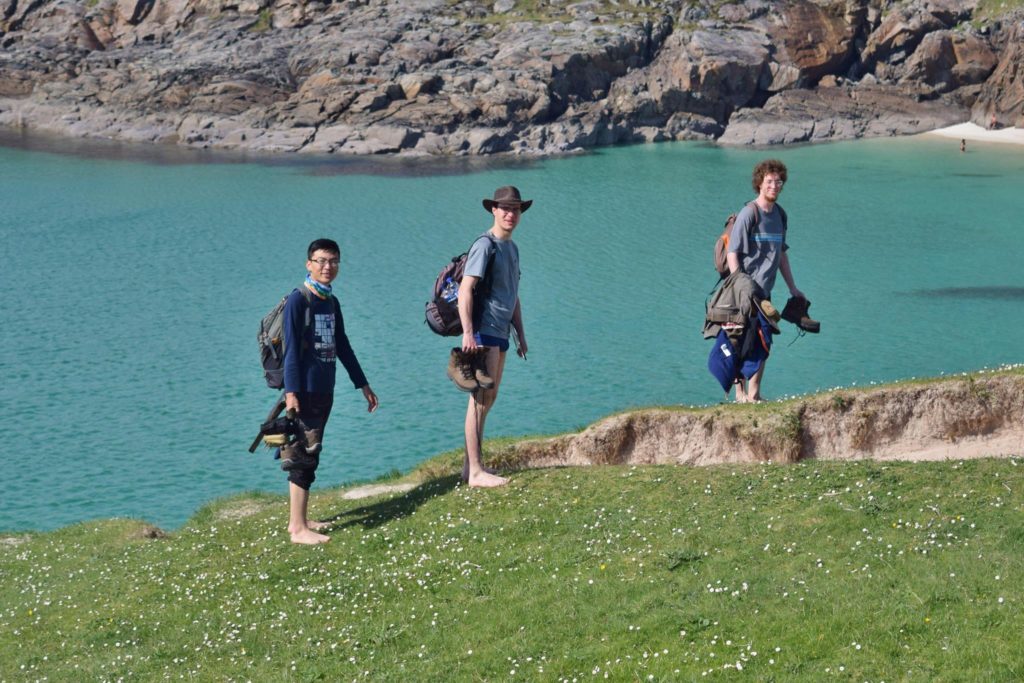
The three musketeers: Alan Liu, Leonluca Klein and Nils Van Weelderen
3. How did you find the weather here?
Where I came from the climate is seasonal. The seasons are distinctive. Scotland doesn’t have seasons. It just has weather. It rains all year around. There are no seasonal effects. The temperature of Edinburgh does not change dramatically. It goes between 0 degree and 20 degree.
The weather here is challenging. It is unpredictable. Heavy winds can give a person quite a great amount of trouble. All the clothes need to be waterproofed.
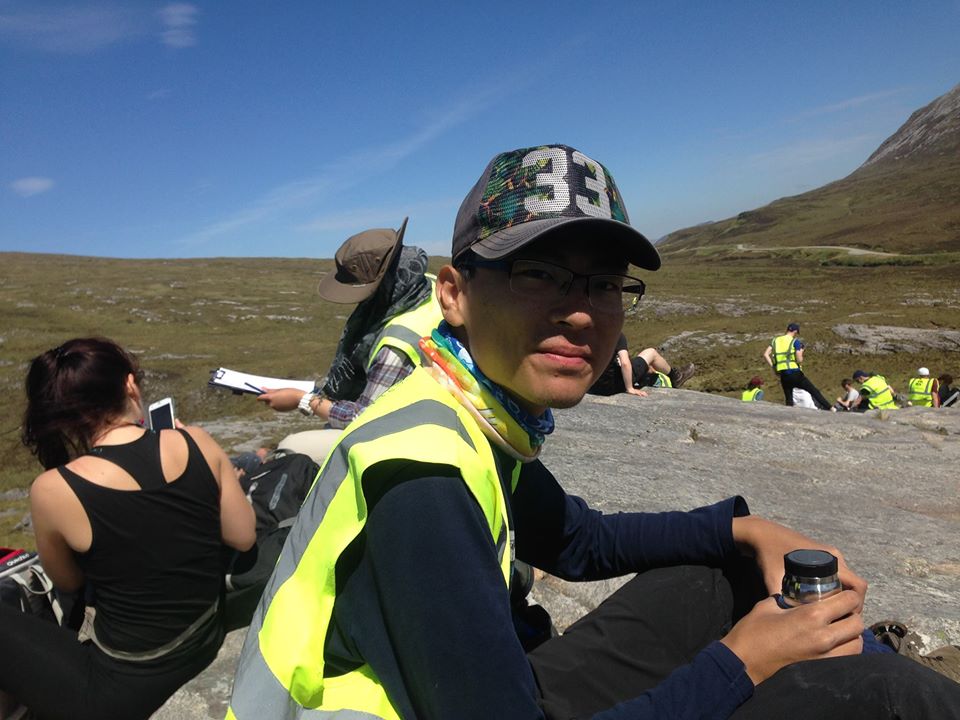
Alan Liu enjoying his stay in the Highlands of Scotland
4. What could UK universities learn from Chinese universities?
Universities from the UK and from China have different styles of teaching. The Education is good here. Joining the university is an individual choice. Here education is a right not a resource, that is for China’s situation. In China you need to have tertiary education to have a good job.
People enter universities because of their love of learning. Not because they need to.
However, China is a great country. It is a 4000-year-old civilization, there is always space to learn from each other and space for cooperation.
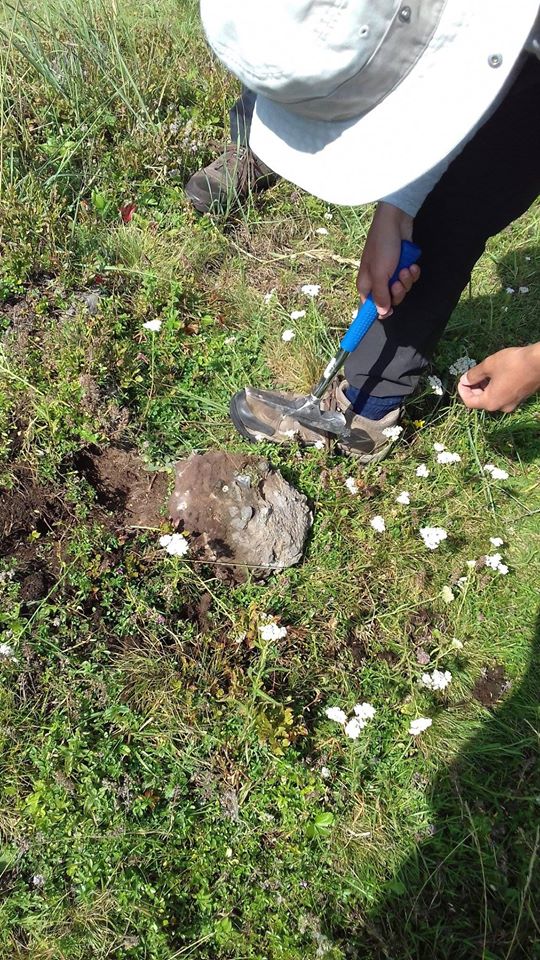
Alan Liu on the Taszok Teto in Romania
5. Now that Brexit has happened are you looking forward to a Global Britain working hand in hand with the People’s Republic of China to bring prosperity to all?
There is always something we can learn from each other. Britain started the Industrial Revolution and China was the latest country to go through it and become the workshop of the world.
There is always time for cooperation.
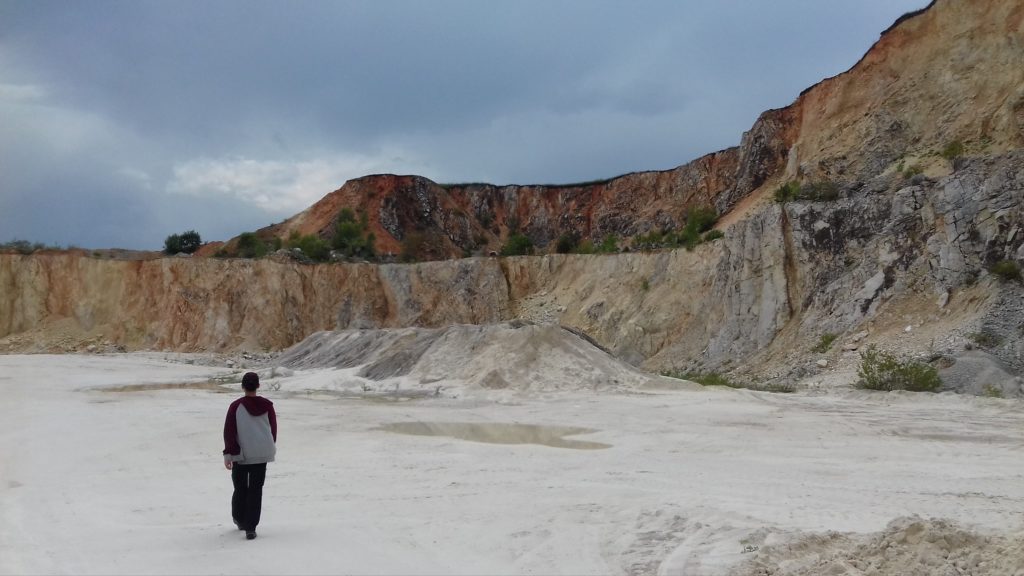
Alan Liu in Romania, in the middle of a Dolomite mine
6. What is your favourite mineral? Why?
Quartz. They are the main substance making up most of the rocks. I like how hardy quartz is. It can survive so much! The shape of the mineral is beautiful, a great Octahedral mineral. It is not very complicated but not very simple. It has a beautiful median complexity.

Alan Liu in limestone caves, in Transylvania
7. What is your favourite geological era?
Cambrian, due to the Cambrian explosion of life.
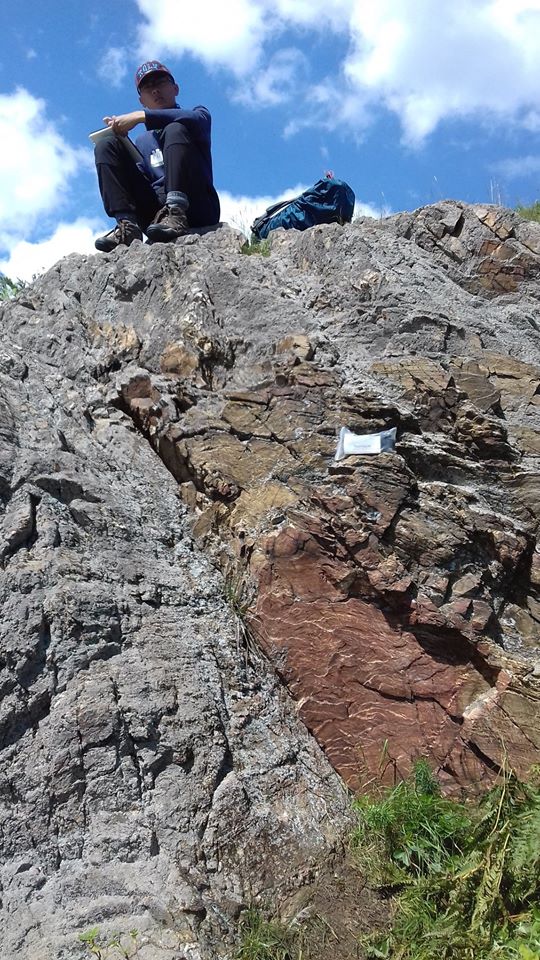
Alan Liu is on top of everything!
8. Any advice to new students in geology? What should they be careful about? What courses should they take?
Quit now! It is not too late!
Ha, ha, ha, it is only a joke!
It is a nice subject to study however it is not great if you want to get a good job after it. If you consider studying it as a short cut to get a good job, and you don’t like the subject itself than you should switch degrees or quit.
Geology is for people who really like this subject. If you don’t like it don’t do it. But if you like it, throw yourself into it. You have a lot to learn.
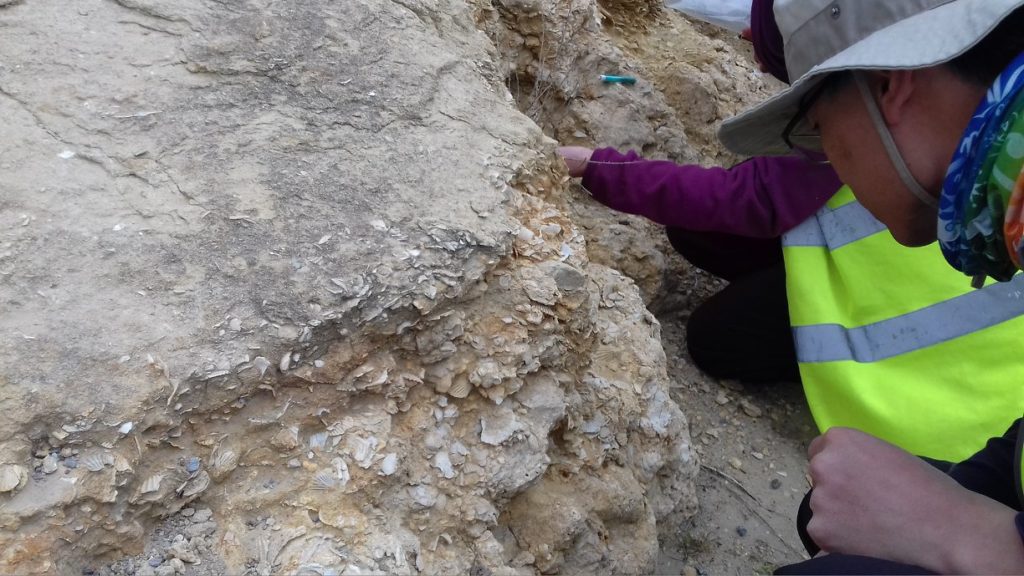
Alan Liu in Spain, looking at fossils
9. Did you enjoy visiting Romania and seeing the geology there? What was your fondest memory?
Yes. Very impressive site with different kind of igneous rocks and a cool metamorphic basement. The field was challenging due to the heavy vegetation. I had to work hard to fin the exposures. The sites over the valley were breath-taking especially in the morning when you could see mist rise from the valley.
The area should be more international as a lot of the books were in local languages. There should be more English translation and people should learn a wider range of languages.
The area is very cool, but it should be more friendly in terms of English speakers.
Romania is a beautiful country.
My fondest memory was trying the food and seeing the beautiful nature. But the specific memory was when we visited an archaeological area with a local professor. We saw ancient carved stones. It was amazing how-to normal people they looked like pieces of rounded rocks, yet the archaeologist could see the cultures of ancient people in it. Seeing geology in a different context was amazing.
It was great spending time with my friend Hunor.

Alan Liu in Gheorgheni, Harghita, Romania looking at igneous intrusions
10. What do you plan to do after finishing your geology degree? What is the future of geology in your opinion?
I have done my Master’s degree already, I finished my degree with the University of Edinburgh. I want to move to a course where we are doing more engineering. I want to focus on my later career.
I want to widen my background into engineering.
Geology has a great future! It is an important structure, but it won’t break into the mainstream. People in these days are more interested in subjects which are towards mathematics and useful applications. People need jobs, so they will move into subjects that give them jobs.
In the future geology will bring great changes to the table but it won’t be studied by everybody. But geology has a wide range of applications.
Most people like to study things like economics, accounting and engineering. Outside of ore mining in my opinion not a lot of students would sign up for courses.
But I enjoyed my time with the University of Edinburgh!
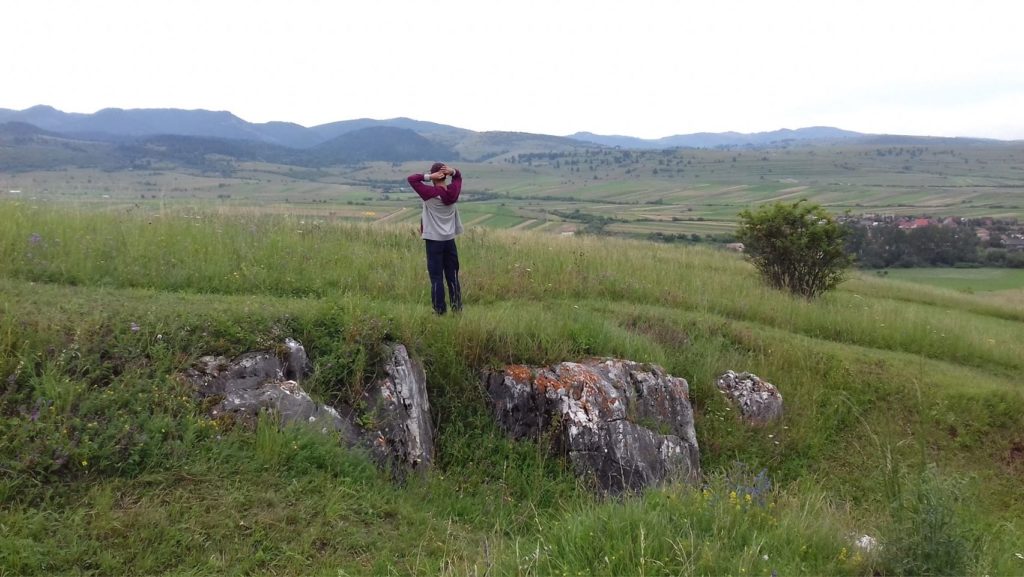
Alan Liu looking to the future horizon
Poem
Poem: The Bedrock Upon which the Forth Bridges are built: 3 Bridges, 3 Centuries
The poem is something different to the topic and to the interview. It is still about geology!
This poem is about the river Forth and the 3 bridges that span it. The poem takes you through the history of the 3 bridges, the eras in which they were built and the underlying geology on which the bridges were built.
Here is a neat geology article about the geology of the river Forth.
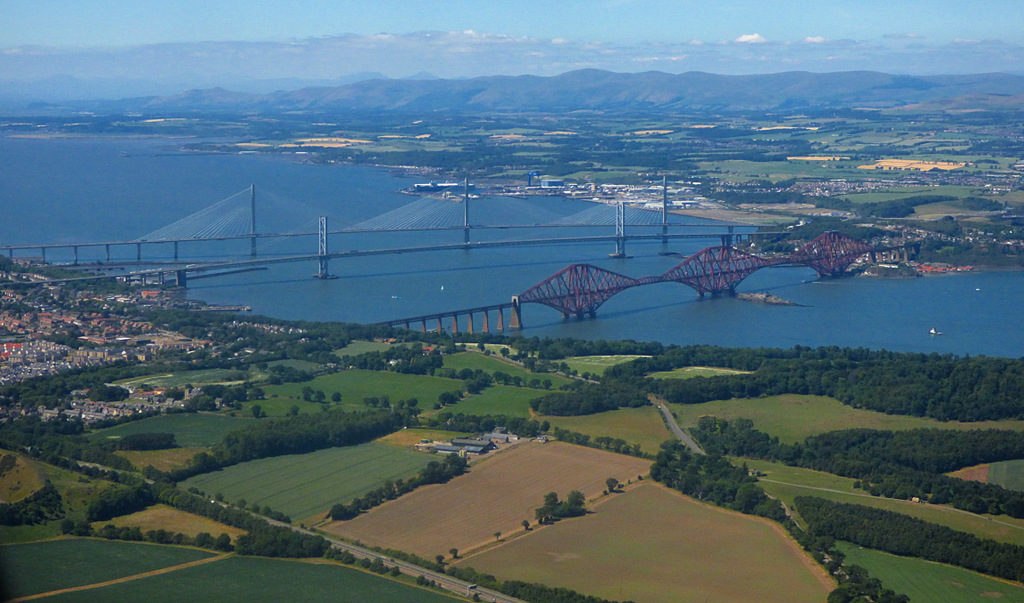
The 3 bridges of the Forth River
The Bedrock Upon which the Forth Bridges are built: 3 Bridges, 3 Centuries
Forth Rail Bridge, built in 1890, emerged from the smog of the Victorians,
Built on the troubled waters separating the Lothians and Fife, on the solid bedrock,
A string of beautiful diamonds, shining amber red diamonds,
Built on a fairy tale of science, engineering, geology, carrying trains towards different horizons.
A world powered by Coal.
Forth Road Bridge, built in 1964, rose in the troubles of the Cold War,
When the motorcar and the oil from shales of the North Sea became the King of the Road,
Since the time of the Empire of Rome, ferries crossed through an estuary carved by ice,
The igneous islands on which the bridges lay, were from volcanoes in their tropical far.
A world powered by Oil.
Queensferry Crossing, built in 2017, in the Age of Information or Fake News,
Steel caissons deeply sank into the quartz dolerite, an ancient igneous intrusion,
Bellow the crystallised rock, lay tuffs and the Sandy Craig formation,
Three bridges, three centuries, yet the geology stays all the same particular.
A world powered by Electricity.
Song/Video
A song about Geology – Brad Paisley
I decided that from now on, at the end of each blog I shall include a favourite song/video of something geology related that I liked.
This week’s is an old favourite of mine: Geology by Brad Paisley. He combined country music with a description of the geological processes which created the Appalachian Mountains:
References
[1] (Sadekov et al., 2013)Sadekov, A. Y., Ganeshram, R., Pichevin, L., Berdin, R., McClymont, E., Elderfield, H., & Tudhope, A. W. (2013). Palaeoclimate reconstructions reveal a strong link between El niño-southern oscillation and tropical pacific mean state. Nature Communications, 4(1), 1–8. https://doi.org/10.1038/ncomms3692
[2] Sánchez-Montes, M. L., McClymont, E. L., Lloyd, J. M., Müller, J., Cowan, E. A., & Zorzi, C. (2020). Late Pliocene Cordilleran Ice Sheet development with warm northeast Pacific sea surface temperatures. Climate of the Past, 16(1), 299–313. https://doi.org/10.5194/cp-16-299-2020




Recent comments